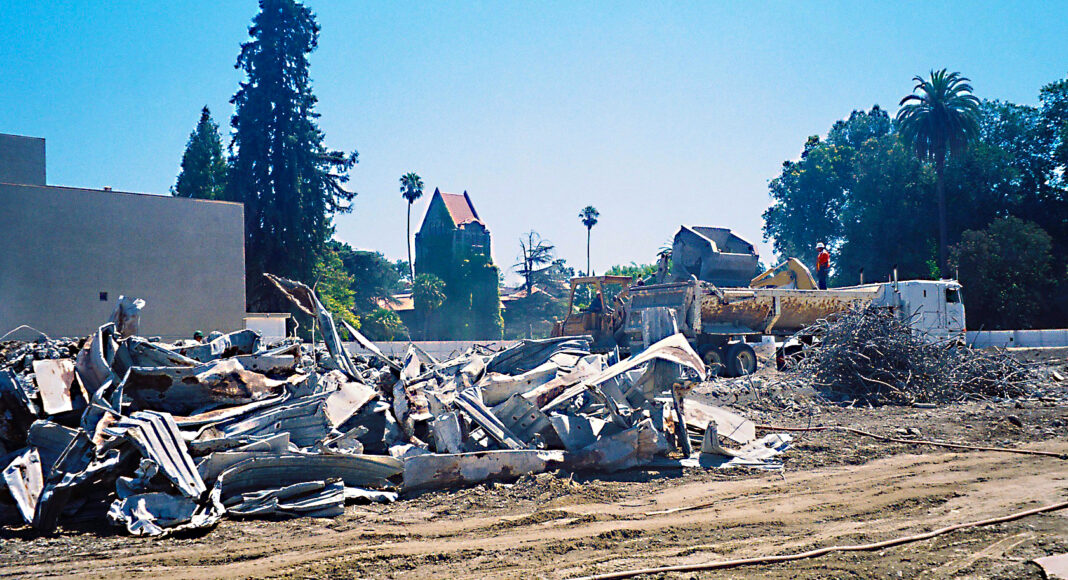Later this year, the Martin Luther King, Jr., Main Library will celebrate 20 years in action, which prompts me to raise the ghosts of Fourth and San Fernando.
Perhaps I should say “raze” the ghosts instead, because as with much of downtown San Jose, the history of library creation and destruction in America’s tenth largest city is a theater of the absurd.
To make a long story short, in 1903, the old Carnegie Library, a classical revival-style fortress, was constructed at Fourth and San Fernando and was the city of San Jose’s public library until it was sold to the college in 1936, after which it became the campus Student Union. Then in the late ’50s it was demolished so that a new six-story wing of the campus library could be built. This library opened in 1961 and was later renamed the Wahlquist Library.
Then in 1982, a new campus library was created in a separate structure entirely, the Clark Library, a building that still stands. From then on, this is where all the newer books were kept, while all books dated before 1975 remained in the Wahlquist Library at Fourth and San Fernando. Are you following me? Good.
By the late ’90s, the old Wahlquist Library had become a crumbling relic of a place. In 2000, it was torn down to build the new MLK Library, which opened in 2003.
I remember the Wahlquist Library in its final years. It was a masterpiece of decay. Plaster tumbled from the walls. It seemed like the elevators took five minutes to go up three floors. The aroma of old books was fantastic.
But the memories don’t stop there. The Wahlquist Library actually adjoined another building that housed the financial operations of the entire university. The controller’s office, payroll, accounts receivable and all the administrative stuff was carried out in those offices.
During my last 18 months in college, a few years before the Wahlquist buildings were torn down, I suffered through a PC tech support job, an $8-an-hour student assistant position, in those very offices. Almost every other student employee in the department was a Vietnamese girl, most of them accounting or finance majors, and I’d show up hungover, wearing a Hawaiian shirt, trying to troubleshoot TCP/IP issues on Windows 95 machines in secretaries’ cubicles. It was at that miserable job that I wrote my first short story, while on the clock, and then found out it was accepted by a literary journal.
Now, 1,600 bylines later, I can admit the old Wahlquist building, now demolished, is what led to my first publication. Even so, it probably needed to go.
But I digress. John T. Wahlquist himself was a far more important figure than I understood at the time. He served as president of San Jose State for 12 intense years, from 1952 to 1964, when it was still a “college” and not yet a “university.” This was a period of serious growth, both on campus and in downtown San Jose.
When Wahlquist took over the job, enrollment at San Jose State was about 7,000. By the time he left, it was over 19,000. When Wahlquist first showed up, the campus was much smaller, bounded by Fourth, Seventh, San Fernando and San Carlos. During his reign, the campus expanded a few blocks eastward and southward, adding several million dollars in new structures.
Wahlquist was also the forward-thinker who lobbied to secure fully accredited engineering classes at San Jose State, which, at the time, were only allowed at the elitist UC schools, not the “broad access” state colleges. Wahlquist went all the way to Sacto and argued his case because he could see the importance of mathematics and electronics technology. His efforts led to the creation of the engineering program, which played a crucial role in the rise of Silicon Valley years later, as even today, local tech firms employ more engineering graduates from SJSU than anywhere else.
Wahlquist, who eventually died in 1990, deserved to have a library named after him, even if it was reduced to rubble by 2000. Every time I visit the current King Library, I raise the ghost of John T. Wahlquist. May his spirit forever lurk in the shadows.



